The Discovery of the Ontogenetic Intelligence of Nature
The following synthesis includes an excerpt from Peter Belohlavek´s discoveries and research works that are published with permission of the author.
Evolution is Purpose Driven
This research began in 1976 with the hypothesis that in nature there are mutations that are random but others that are driven by a purpose. If this hypothesis was confirmed and there were a purpose, the author concluded that there would have to be an intelligence that defined such purpose.
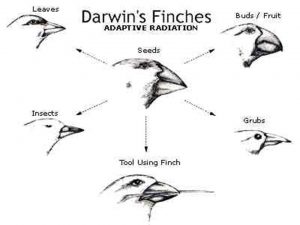 For this reason, he researched on the essential structure implicit in nature’s intelligence to be able to predict and exert influence on the evolution of complex adaptive systems when possible.
For this reason, he researched on the essential structure implicit in nature’s intelligence to be able to predict and exert influence on the evolution of complex adaptive systems when possible.
Charles Darwin demonstrated the adaptation process of species that, having the same structural constitution, developed adaptive changes to live in a certain environment. The hypothesis of the research was that these changes were driven by an intelligence that underlies nature.
He concluded that each living creature’s evolution is ruled by its ontogenetic intelligence, that defines it as unique both in its species and individuality and that the essential structure of this intelligence is integrated by a purpose, an active principle (entropic function) and an energy conservation principle.
The research was focused on the unified field of living beings. The basic assumption that sustains this development is that the evolution of living beings, their behaviors, actions and deeds are driven by the same logical structural framework.
This implies that there is an intelligence that defines the structural behavior of any entity that integrates this framework that allows predicting the behavior of all the entities where this intelligence is known.
The Objectives of the Research
The objective of this research was to develop a technology that allowed predicting the evolution of specific aspects of complex adaptive systems and developing solutions to exert influence on such evolution.
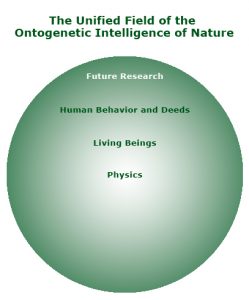 The research dealt specifically with complex adaptive systems such as living beings, their behaviors, actions and deeds.
The research dealt specifically with complex adaptive systems such as living beings, their behaviors, actions and deeds.
It is necessary to accept that dealing with the intelligence that underlies nature is a complex problem that is extremely abstract and can only be understood by using it in the real world.
This discovery made complex adaptive systems reasonable, understandable and predictable in those cases in which the structure of the intelligence that underlies their nature has been found.
This research process that began in 1976 was a step by step approach. It began with the development of what has been called the “three-dimensional multivariable analytical methodology” – that allowed apprehending and managing the nature of human actions and deeds – and ended when the Theory of Evolution was completed and the emulation of the organization of nature became possible.
The research began in the field of social, economic and behavioral sciences.
Then it evolved, driven by homologies with confirmed knowledge, towards life sciences and ended with physics to confirm the validity of the unified field. This process demanded almost 40 years and is still ongoing.
Ontogenetic Intelligence of Nature, Unicist Ontology and Concepts
You will find that this document deals with the ontogenetic intelligence of nature named concept and its structure, defined by the unicist ontology.
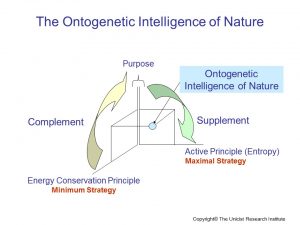 The ontogenetic intelligence of nature defines the nature of an entity. As such, its structure was named unicist ontology and the name given to this intelligence was concept.
The ontogenetic intelligence of nature defines the nature of an entity. As such, its structure was named unicist ontology and the name given to this intelligence was concept.
The name concept was used because if “the concept of a concept” used in philosophy is studied, it becomes evident that the idea of something pretends to define its nature.
It has to be considered that the research of the intelligence that underlies nature needs to be measurable, that is why this could only be done in the unified field where the results were measurable.
This research has been developed using the methodology of complex adaptive system research where all the elements are integrated by the conjunction “and” and there are no univocal cause-effect relationships.
The ontogenetic intelligence of nature discovered defines that there are only two types of relationships in the world: a complementary relationship and a supplementary relationship, integrated in a triadic function.
This drove to the development of the unicist double dialectical approach that allows dealing with complex problems using a logical approach. The unicist double dialectical approach is a rational emulation of the ontogenetic intelligence of nature that allows apprehending the dynamics of evolution. This made the development of the Unicist Logic possible.
The Ontogenetic Intelligence of Nature
The unicist ontology of evolution explains and predicts the evolution of living beings, their produces and their actions in a unified field, ruled by concepts and their natural laws. These natural laws have been named as “Ontogenetic Intelligence”.
The research of the unicist ontology of evolution did not enter the field of the origin of life or the origin of the universe. The purpose of the research was to discover the origin of the rules of evolution, to diagnose and influence it.
The most relevant application fields are future research, strategy, institutional evolution and Man’s individual development and his learning process.
This theory enables the analysis of and influence upon complex realities. Its reliability has been proven in its application during the last three decades.
The development of this theory started in 1976 and ended in 2003 with the discovery of the origin of fallacies. Fallacies have been and remain a major obstacle to overcome for the understanding of institutions, countries and individuals.
The discovery of the structure of concepts ruling the evolution of living beings set the grounds for The Unicist Ontology of Evolution.
The theory fathoms into the most censored aspects of human behavior: into his own evolution. That is why it is a taboo, and must be treated as such.
The consideration that concepts define the ontogenetic intelligence of living beings is recent.
The consequence of this statement is that the intelligence of living beings is necessarily based on the double dialectic self-organized approach to reality.
Dysfunctionalities of the ontogenetic intelligence endanger the evolution of the living being.
The lack of the conservation principle fosters “explosion”, the lack of the action principle promotes “implosion”.
The applications of the unicist ontology of evolution to biological, individual, institutional and social forecasts were the fields were this theory was validated and falsified (at the level that is falsifiable).
This ontology approaches evolution in the world of possibilities to discover concepts and operates in the world of probabilities to influence them.
Ontogenetic Intelligence
Ontogenetic intelligence defines the basic laws of evolution. It is a set of what can be called natural laws which rule the evolution of living beings.
It was researched in order to find an approach to forecast and influence evolution.
Ontogenetic intelligence is defined by two principles of nature:
- The action principle that sustains growth and evolution. It is driven by expansion.
- The energy conservation principle, which sustains survival and avoids involution. It is driven by contraction.
In the field of human behavior, the action principle gives birth to the verbal function, which makes the fulfillment of purposes possible. The entropy produced by action produces changes in the goal of purposes.
To avoid changes and sustain the purpose, the energy conservation principle produces a homeostasis. The homeostatic value complements the purpose and ensures that action occurs within the established limits.
But the consequence of this interaction is never deterministic. The change produced by the interaction of the living being with the environment produces evolution or involution.
In nature, both principles sustain the evolution of living beings. Their effects can be observed in bacteria, viruses, cells, and other living beings.
At a more operational level, besides the expansion and contraction principles, there are functions that provide security and functions that provide freedom to living beings. These functions are implicit in the upper level functions (expansion – contraction).
Ontogenetic intelligence provides the basic rules to adapt to an environment. It sustains the living being’s unstable equilibrium. When, for any reasons, the ontogenetic intelligence is inhibited, the living being loses its equilibrium and its survival is endangered.
These principles are active in individual beings and in the live environment they are part of.
Ontogenetic Principles
Ontogenetic intelligence has two basic principles that influence evolution.
It supposes the existence of a purpose of the living being. On the one hand, there is an expansion principle and, on the other hand, there is a contraction principle.
 Evolution is never in equilibrium. Considering a moment, every system is either in expansion or in contraction.
Evolution is never in equilibrium. Considering a moment, every system is either in expansion or in contraction.
This integration of contraction and expansion to sustain a purpose defines the ontointelligence of a being.
The active function describes the verbal function that seeks the expansion of the living being.
Therefore, entropy is implicit. Where there is an action there might be entropy. Entropy is measured by the fulfillment of the purpose.
To avoid the entropic effect there is an adverbial function which sustains the purpose.
There is no causative relation between the conservation function and the active function (verbal function). They are integrated by the purpose of the living being.
Evolution implies an improvement of the adaptation to the environment.
When adaptation reaches an extreme level, it reaches the utopia point where there is no differentiation between the being and the environment, therefore the “individual being” disappears.
This is the effect of the instability zone 1, which works as a sort of “black hole”. It has the same effect as an implosion.
The information of the preceding individual disappears giving birth to a new identity within a more comprehensive unified field.
When individuals are in involution, they inevitably arrive at a level where they have to mutate to survive in some other way. They mutate or “die”.
This is the effect of what we call instability zone 2. The behavior of the individual loses its adaptive capacity and the effect is chaotic behavior. In such scenario, the individual seeks new ways to adapt to the environment.
Sometimes the individual is able to mutate, sometimes it simply explodes.
What has been described is the functioning of ontogenetic intelligence which we consider included in the meaning of the word concept.
The word concept has been used in the past with multiple meanings. But considering the root of the meaning it always refers to the “nature” of something.
That is why we use the word concept defining its ontogenetic intelligent structure which sustains the adaptive behavior of living beings.
Concepts
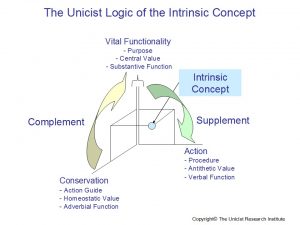 Concepts describe the living creatures’ essences and their evolution laws. That is what we call their ontogenetic intelligence.
Concepts describe the living creatures’ essences and their evolution laws. That is what we call their ontogenetic intelligence.
Living creatures possess intrinsic concepts. This means that these concepts exist in themselves and only need to be discovered.
On the other hand, inanimate beings have extrinsic concepts, which are deposited on them according to their functionality.
Concepts determine the ontological behavior of living creatures.
As there is a generic concept for each species that defines its purpose, its expansion action (entropy) and its conservation function, such concept is cross-cultural and timeless, as long as the species does not become extinct.
Functionality/Credibility Zone
Intrinsic concepts are functional. They do not exist because someone believes them or not.
On the other hand, extrinsic concepts describe the ontology of a living being and depend, for their existence, on the fact that they are believed.
While intrinsic concepts are defined by their functionality zone, extrinsic concepts are defined by their credibility zone.
In both cases, concepts are not integrated by three different elements, they are “one”.
The Field of Possibilities
Concepts define the field of possibilities of occurrence of events.
- Intrinsic concepts define the possibilities of the nature of the entity. The behavior of a living being becomes influenceable if the knowledge of its concepts has been acquired.
- Extrinsic concepts define the possibilities of inanimate entities. The building and use of inanimate entities becomes possible if the knowledge of their concept has been acquired.
- Extrinsic concepts also define the possibilities of objects that are being built. Objects, as adaptive systems that need to produce results, are based on concepts that drive their functionality.
Concepts Behave as Strange Attractors
Behavior oscillates, with higher or lower frequency, between expansion and contraction, and at the same time between security and freedom.
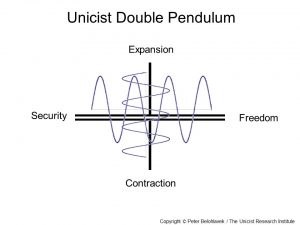 This double oscillation makes concepts behave as strange attractors. When a given behavior moves towards freedom, it will return seeking for security.
This double oscillation makes concepts behave as strange attractors. When a given behavior moves towards freedom, it will return seeking for security.
The amplitude or importance of the qualitative and quantitative modification does not necessarily determine the amplitude or importance of the next move.
The same phenomenon happens when moving towards expansion or contraction. Therefore, within the credibility zone behavior appears as chaotic, but following the patterns of the behavior of strange attractors.
Possibilities define the existence of a functionality/credibility zone while probabilities define the behavior within the functionality/credibility zone.
In intrinsic concepts, possibilities define the existence of a functionality zone but probabilities define the behavior within such zone.
In extrinsic concepts, possibilities define the existence of a credibility zone but probabilities define the behavior within such zone.
Complementation and Supplementation Laws
 The purpose, the conservation function and the active function of a concept are integrated by logical rules which sustain their unity.
The purpose, the conservation function and the active function of a concept are integrated by logical rules which sustain their unity.
While the purpose and the active function are sustained by the supplementation law, the purpose and the conservation function are integrated by the complementation law.
Supplementation Law
It is a relation between elements with redundant purposes and verbal functions, having a different homeostatic element. One of the elements has a superior “myth” that challenges the evolution of reality.
Complementation Law
It is an interdependent relation between two elements, actions or ideas. Each one of these elements has what the other element requires and they both have a coincident homeostatic element.
Complements sustain the weaknesses of the purpose to avoid the entropy produced by the action.
When the homeostatic value can buffer the changes produced by the active function, the functionality/credibility zone is relatively stable.
The Unicist Theory: A Paradigm Shift in Science
The Unicist Theory, developed by Peter Belohlavek, is a paradigm shift of the scientific approach to complex adaptive systems. The Unicist Theory has substituted empiricism by a pragmatic, structuralist and functionalist approach and has replaced knowledge falsification processes with destructive testing processes.
This theory provides an approach to complexity based on the use of the unicist logic that emulates the intelligence that underlies nature. It integrated complexity sciences with systemic sciences in a unified field.
The Unicist Theory allowed understanding and influencing the evolution of living beings and artificial complex adaptive systems. This influence is exerted by using unicist logic and unicist technologies, which is now a worldwide trend.
The Unicist Theory was developed at The Unicist Research Institute to deal with complex adaptive systems and their evolution.
There are fields that are generally accepted as being complex such as: Life sciences, social sciences, anthropology, political sciences, economic sciences, behavioral sciences, medicine, psychology, education, businesses, ecology and meteorology. The research began in 1976 and the expansion of its applications is still ongoing.
The Unicist Theory comprises the following discoveries:
- The Ontogenetic Intelligence of Nature, which describes the essential structure of nature that drives its functionality and evolution.
- The Unicist Ontology, which is a model that allows emulating the ontogenetic intelligence of nature in order to make it apprehensible.
- The Unicist Logic, which allows emulating the triadic structure of the ontogenetic intelligence of nature using a unicist double-dialectical thinking process.
- Conceptualization, which establishes the process of apprehending the concepts that represent the unicist ontology of an entity using unicist-logical thinking.
- The Unicist Ontology of Evolution, which establishes the basic rules of evolution and involution.
- The Ontogenetic Maps, which describe the unicist ontogenetic algorithm of complex adaptive systems.
- Unicist Objects, which are adaptive systems that integrate complex systems to drive their functionality.
Scientific Evidences of the Unicist Theory
The objective of the scientific evidences of the Unicist Theory is focused on:
- Confirming the existence and functionality of the ontogenetic intelligence of nature.
- Confirming the structure of the unicist ontology that emulates the ontogenetic intelligence of nature and allows defining the structure of complex systems.
- Confirming the functionality of the unicist double-dialectical logic to go beyond dualism, which hinders apprehending reality as a unified field, in order to be able to emulate the intelligence of nature.
- Confirming that concepts are defined by the ontological structure of an entity and, as Immanuel Kant discovered, have a functional meaning that is the framework of any possible action.
- Confirming the functionality of unicist objects that are built emulating the objects in nature like the organs in the human body.
The scientific evidences of the Unicist Theory that confirm its functionality to deal with complex systems are:
- The functionality of amino acids
- The structure of atoms
- The structure of biological entities
- The nervous system
- Similarity between natural and social objects
- Unicist concepts working as stem cells
- The thinking processes and the functionality of electricity
You can find the complete document on “The Unicist Theory, its Applications and Scientific Evidences” at: http://www.amazon.com/gp/product/B00ZRW6E6A
Unicist Epistemology: understanding Complex Systems
The Unicist Epistemology is based on the development of the logical foundations and the empirical justifications to sustain human knowledge. This epistemology is a pragmatic, structural and functionalist approach to knowledge.
Knowledge is such when its use allows individuals to better adapt to an environment. To be used, it needs to be stored in the individual’s long-term memory.
The credibility of knowledge depends on having found the fundamentals that integrate the concept that defines the nature of an entity and having the necessary empirical justifications to make knowledge tangible.
The Unicist Epistemology was developed to build reliable knowledge to understand complex adaptive environments.
Access an introduction to the Unicist Epistemology at:
http://www.unicist.org/repo/#Think-Tanks
Synthesis of the Unicist Ontology of Evolution
A living creature’s evolution is ruled by its concept. The concept is the functional logic structure of a living creature that defines it as unique both in its species and individuality.
Each living creature has a central concept that regulates its evolution and describes its purpose, the procedure under which it faces adaptation to reality and the action guide within which it develops the procedure so as not to trespass the limits of its purpose.
The concept describes a living creatures’ functionality. It defines its intrinsic concept.
Living creatures naturally transfer this functionality to the environment where they act, depositing functions that have the living creature’s same logic structure and that generate the existence of extrinsic concepts.
These concepts have the same logic structure but they are not implicit in inanimate beings; they are deposited by the living creatures they are functional to.
The concept arranges the living creatures’ chaos. It is the attractor which structures the chaotic behaviors of a living creature’s environment and arranges them to make them operable and functional to evolution or involution, should any be the case.
Introduction to Evolution
There is evolution whenever a being, as an individual or as species, institution, culture or a given reality reaches a higher level of functionality in its process of adaptation to environment.
 There is a higher functionality when his capacity to influence the environment increases, and with it, his added value and his capacity of self-growth. Whenever he does so at the expense of the environment, there is involution.
There is a higher functionality when his capacity to influence the environment increases, and with it, his added value and his capacity of self-growth. Whenever he does so at the expense of the environment, there is involution.
There is also involution when the level of functionality decreases.
In order to understand an evolution theory one needs to be operating it in a field of reality whose completeness one has fully apprehended.
Whenever one does not perceive it within the sphere one is fully adapted to, that is, is influenced by and bears influence on, adds value and gets value in return, an Evolution Theory is solely apprehended from a rational stand, thus transforming it necessarily in mechanic and deterministic.
Therefore, all those interested in apprehending The Unicist Ontology of Evolution should read it seeking an intrinsic logical structure and its value added to fields where the reader can adapt perfectly well.
This implies that in order to actually apprehend an evolution theory one should imagine it as explaining fields where the one interested does not need an Evolution Theory.
All rational learning of an evolution theory inevitably leads to taboo and thus, to the lack of understanding.
Chaos and Evolution
According to the Unicist Ontology of Evolution, chaos does not exist in objective terms; chaos is any situation within which the individual does not manage to structure the evolution of a complex system.
Complexity is an issue related to the observer and thus, chaos theory is a theory of Man’s subjectivity in its attempt to influence a given reality.
All along the process of analysis of evolution, contemplated from different viewpoints we will describe chaos as the consequence of exerting influence on realities whose laws of evolution remain unknown.
Living Creatures
Living creatures are those able to adapt, reproduce, grow and die by themselves. The transcribed living creature concept may be decomposed into sub-concepts that regulate the evolution of the living creature’s “sub-systems”.
There are artificial life beings which follow the same rules than living creatures.
For instance, institutions have an “artificial life” provided they can adapt, reproduce, grow and die. Therefore, those institutions which are beyond the men integrating them have intrinsic concepts.
Unicist Ontology of Evolution
The Unicist Ontology of Evolution structures how the “infinite” elements that participate in evolution are arranged around concepts which offer functionality models and which, when exceeded by actions, produce chaotic instants that end up in death or in a new order with new functional concepts.
This explains why The Unicist Ontology of Evolution is far from being a deterministic theory; it structurally operates in the world of possibilities, and in terms of conjuncture, in the world of probabilities.
There are no probabilities in the conceptual world; everything is “possibility”.
These possibilities are infinite a priori and, in the light of functional concepts, they arrange and offer a finite span of possibilities which make it possible to forecast what is going to occur, provided there is no unexpected “butterfly effect”.
The Unicist Ontology of Evolution asserts that concepts regulate the living creature’s functionality and evolution.
Living creature’s development is ruled by the evolution of their intrinsic concepts. A concept is an operational logical structure that determines a living creature’s functionality.
Therefore, concepts describe both the living creatures’ essences and their evolution laws.
This means stating the fact that concepts preexist within the subject and imply a huge difficulty to be apprehended. Concepts can only be discovered, they cannot be “built”.
Concepts define the ontological behavior of living creatures. At the same time, concepts exert influence on the living creatures’ functionality and adaptation to the environment, and they also structure their evolution.
By living creatures it is understood all those that are capable of growing, reproducing, adapting to the environment and dying by themselves.
The living creature concept contains a finite number of sub-concepts that regulate the operation of the living creature’s subsystems but which are also conditioned to it.
Living creatures, human beings in particular, can only have a very partial access to their concepts although they can approach sub-concepts which are functional to their observable activities.
This is how they are able to understand evolution without having to reach those ultimate structuring causes.
The Unicist Ontology of Evolution is not deterministic since the possibilities opened in the conceptual structures are so huge that it can only determine tendencies in situations where the living creature evolves or involves.
When a living creature enters chaos, because its concept became dysfunctional to the environment it acts upon, there is no possibility of forecasting its evolution except for the assertion that chaos will come to an end.
Chaos will end up either in the living creature’s death or in a new functional concept better adapted to the environment.
It is easier to forecast involution that evolution. Involution has a clear end: “death”. Evolution offers multiple possibilities.


